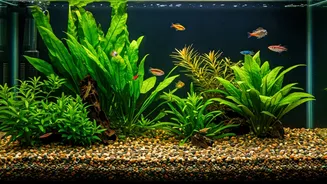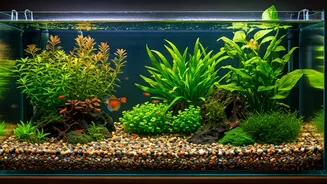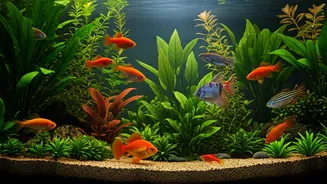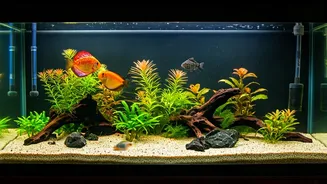Betta Fish: Vibrant Choice
Betta fish, often called Siamese fighting fish, are popular choices for beginners due to their striking colors and relatively easy care requirements. Bettas
thrive in small tanks, making them suitable for limited spaces. It's crucial to keep male bettas separate, as they are aggressive toward each other. A single male betta can be housed comfortably in a 5-gallon tank, while females can coexist with others in larger tanks. They prefer a water temperature between 75°F and 80°F (24°C and 27°C). Bettas eat commercial betta pellets, and occasional treats like bloodworms or brine shrimp can enhance their diet. Regular water changes and a properly filtered tank contribute to their health and longevity. Ensuring a well-maintained environment is key to keeping these beautiful fish happy and healthy, allowing them to display their vibrant colors. Remember that these beautiful fish should not be kept in a small bowl as it will restrict their movement.
Guppies: Colorful & Social
Guppies are another fantastic option for novice fishkeepers, known for their lively personalities and prolific breeding. These small, colorful fish are very adaptable and can tolerate a wide range of water conditions, making them ideal for beginners. Guppies are livebearers, meaning they give birth to live young, which can quickly populate a tank if not managed. A small group of guppies can be kept in a 10-gallon tank, but provide more space as their population grows. The water temperature should be kept between 72°F and 82°F (22°C and 28°C), and a good filter is essential for water quality. Guppies are omnivores and will eat a variety of foods, including flakes, pellets, and occasional treats. Regular water changes and a balanced diet will help keep them vibrant and healthy. Consider adding some plants to their aquarium to provide hiding places and enhance the aesthetic appeal of the tank. Guppies are often active swimmers and bring a lot of enjoyment to any aquarium setup.
Tetras: Peaceful Community
Tetras, particularly the neon tetra, are excellent choices for a beginner's community tank. These small, schooling fish are known for their peaceful nature and vibrant colors, adding beauty to any aquarium. Neon tetras need at least a 10-gallon tank to thrive, preferably in a group of six or more to mimic their natural social behavior and reduce stress. The water temperature should be kept between 72°F and 78°F (22°C and 26°C), and the water should be slightly acidic. Tetras eat flake food and small invertebrates. Maintaining a clean environment is crucial for tetra health; regular water changes are essential. They prefer a well-planted tank with plenty of hiding places. Compatibility with other peaceful community fish is important for a harmonious aquarium. These vibrant fish are a joy to watch and will bring movement and color to your aquarium.
Corydoras: Bottom Dwellers
Corydoras catfish, often called Corys, are friendly bottom-dwelling fish that are great additions to a community tank. These small, armored catfish are known for their playful behavior and efficient scavenging abilities. Corydoras help keep the tank clean by eating leftover food and debris. They thrive in groups of six or more and prefer a sandy substrate to protect their barbels. They are comfortable in water temperatures between 72°F and 82°F (22°C and 28°C). Corys are omnivores and will eat sinking pellets, flakes, and occasional treats. It's essential to maintain water quality through regular changes. They contribute to a healthy ecosystem by consuming food waste and keeping the substrate clean. The addition of plants and hiding places will make them more comfortable. They are peaceful and compatible with other community fish. Corydoras add an extra layer of interest to a beginner's aquarium.
Mollies: Active & Hardy
Mollies, another live-bearing species, are hardy and relatively easy to care for, making them suitable for beginners. They come in a variety of colors and patterns and add liveliness to a tank. Mollies need a minimum of a 20-gallon tank, with the space increasing depending on how many you want to keep. They are somewhat tolerant of a range of water conditions, including slightly brackish water, which might be necessary in some cases, although not all molly species require it. The water temperature should range from 72°F to 82°F (22°C to 28°C). Mollies are omnivores and will eat flake food, algae, and occasional treats. They are active swimmers and add interest to any aquarium. Maintaining good water quality is essential, and regular water changes help prevent diseases. Mollies are known to breed easily, so it's essential to manage the population if you wish to avoid overcrowding.
Platies: Colorful & Resilient
Platies are a popular choice for beginners due to their vibrant colors and hardiness. These live-bearing fish are easy to care for and adaptable to various water conditions. They come in a multitude of colors and patterns, adding beauty to any aquarium setup. Platies typically do well in a community tank with other peaceful fish. A 10-gallon tank is often sufficient for a small group. Water temperature should range from 70°F to 80°F (21°C to 27°C). Platies are omnivores and will readily eat flake food, algae, and some plant matter. They are generally peaceful and get along well with other species, making them a great addition to a community tank. Regular water changes and a balanced diet are key to keeping them healthy. They are known for their active swimming and bring a lot of movement and color to the aquarium.
Goldfish: Classic Choice
Goldfish are a classic choice for many aquarists and are relatively easy to care for if given the proper environment. These hardy fish come in a variety of breeds and sizes, but they require a spacious tank due to their waste production and growth. A single goldfish needs at least a 20-gallon tank and ideally, more space as they grow. Goldfish prefer cooler water temperatures, between 65°F and 75°F (18°C and 24°C). They produce a lot of waste, making a strong filter essential. Overcrowding and poor water quality can lead to several health issues. They thrive on a diet of flake food, occasional treats, and plant matter. The goldfish's lifespan can be quite lengthy if properly cared for. While goldfish are beginner-friendly, providing enough space and keeping the tank clean are crucial for their health and happiness.
Harlequin Rasboras: Community Friendly
Harlequin Rasboras are small, peaceful schooling fish that are excellent for community tanks. These fish are known for their striking appearance and compatibility with other non-aggressive species. Harlequin Rasboras thrive in a well-established tank with plenty of plants and hiding places. They do best in a group of six or more, with at least a 10-gallon tank. Water temperature should be maintained between 72°F and 79°F (22°C and 26°C). They are omnivores and will eat flake food, small insects, and other foods. Regular water changes are critical to maintaining their health, and a well-filtered environment is a must. These fish are active swimmers and bring a lot of activity to the mid-level of the tank. Their schooling behavior and peaceful nature make them a great choice for beginner aquarists.
Zebra Danios: Active & Easy
Zebra Danios are incredibly active and resilient fish, making them a superb selection for new aquarists. These fish are hardy and adapt to a variety of water conditions. They're also known for their playful nature and striking stripes. Zebra Danios need at least a 10-gallon tank and do best when kept in groups of six or more. They prefer water temperatures between 64°F and 74°F (18°C and 23°C), and can handle cooler temperatures. They are omnivores and will happily consume a variety of foods, including flakes, pellets, and treats. Regular water changes and a clean environment are crucial for their health. Zebra Danios are top swimmers, adding continuous movement to your aquarium. The ease of care and fascinating appearance make them a winning option.
Dwarf Gourami: Peaceful Beauty
Dwarf Gouramis are colorful and peaceful fish that bring elegance to a community tank. These fish are known for their intricate patterns and gentle demeanor. They are relatively easy to care for. Male dwarf gouramis tend to be more brightly colored, and they can be housed with other peaceful species. They require a minimum of a 10-gallon tank, with more space needed for multiple gouramis. Water temperatures should be kept between 77°F and 82°F (25°C and 28°C). Dwarf gouramis are omnivores and should be fed a varied diet, including flakes, pellets, and occasional treats like bloodworms. Maintaining good water quality is essential, and regular water changes help prevent diseases. They prefer a tank with live plants. Dwarf gouramis add both color and character to the aquarium and are an excellent choice for a beginner's community tank.











